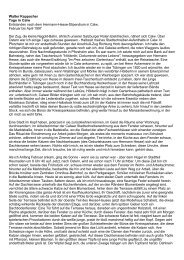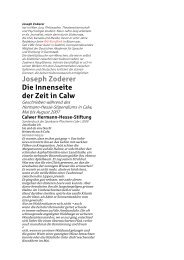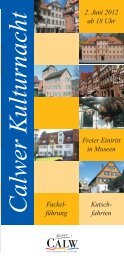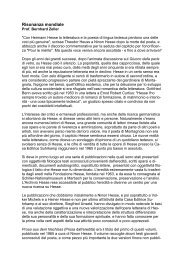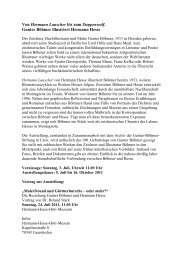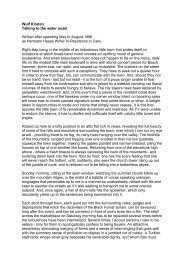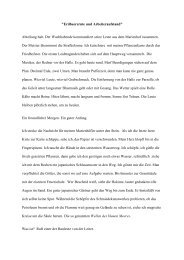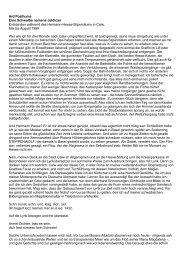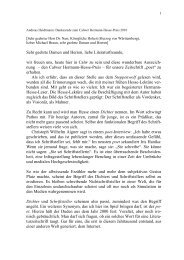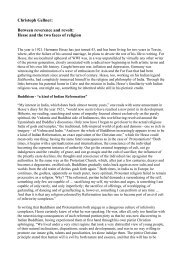Ragni-Maria Seidl-Gschwend The Wolves of Zavelstein Written after ...
Ragni-Maria Seidl-Gschwend The Wolves of Zavelstein Written after ...
Ragni-Maria Seidl-Gschwend The Wolves of Zavelstein Written after ...
Create successful ePaper yourself
Turn your PDF publications into a flip-book with our unique Google optimized e-Paper software.
Soon <strong>after</strong> one passes Kentheim, a road branches <strong>of</strong>f to the right towards <strong>Zavelstein</strong>, and Ispontaneously decided to take the little diversion via the mountain in order to pass throughthis enchanting little town once again. I parked the car in front <strong>of</strong> the “Lamm” restaurant,which was closed either just that day or for its annual holiday. And the whole place, in fact,had a deserted feel to it. <strong>The</strong> flowers decorating the houses had either been taken in orfallen victim to the overnight frost, and nothing more appeared to be available up here tothe spa guests from Bad Teinach. <strong>The</strong> shop on the corner was probably still closed forlunch, and no one else was about either. All that was to be seen was a large, alreadyrather old, somewhat mangy-looking dog lying in the road, warming its greying fur in thepale November sun. As I walked past, it got up and trotted along beside me. My thoughtswere still so much caught up with the translation business and Hermann Hesse that I wasat first not at all surprised when the dog - for there was no one else to be seen either far ornear - suddenly began to growl:Ich Steppenwolf trabe und trabe,die Welt liegt voll Schnee,vom Birkenbaum flügelt der Rabe,aber nirgends ein Hase, nirgends ein Reh!While I was still wondering how one might translate the highly vivid, though rather unusualverb “flügeln” into another language, my companion, who could no doubt have trotted outthe entire poem, suddenly froze up, since a second, slightly reddish and somewhat smallerand younger-looking animal (no, I can no longer speak <strong>of</strong> “dogs,” for I had since noticedtheir close-set yellow eyes and the low-hanging tail) came bounding out <strong>of</strong> the narrowstreet by the church and began tripping lankily along beside us:<strong>The</strong> Wolf trots to and fro,<strong>The</strong> world lies deep in snow,<strong>The</strong> raven from the birch tree flies.But nowhere is a hare, nowhere a roe.Why, I wondered, did he not introduce himself, and why speak only in general terms <strong>of</strong>“the wolf”? Yet no time remained for longer deliberations, for events now began to occur inrapid succession. Barely had we passed the little wooden bridge over the moat when wecame across an elegant black wolf at the entrance to the ruin. He took up a pose anddeclaimed, not without pathos:Lo lupo della steppa trotto solosolo, nel mondo ormai di neve bianco.Dalla betulla scende un corvo stanco,ma non vedo una lepre, un capriolo!He subsequently joined our party, and together we headed on towards the castleprecincts, where we were received by a veritable pack <strong>of</strong> beasts, all <strong>of</strong> them yapping,barking, howling, whimpering, growling. and making whatever other kinds <strong>of</strong> noises wolvesmake, in all conceivable shades and nuances <strong>of</strong> sound.Cold though it was, I sat down on a stone, the ur-Steppenwolf squatted down in front <strong>of</strong>me, and the other animals settled down in a semicircle around us. I was particularly struckby a group <strong>of</strong> light-furred wolves, obviously hailing from more northerly regions, and inresponse to my questioning gaze the liveliest <strong>of</strong> them stood up (it was almost like being atschool!) and began:
Would they, I thought, believe the business about the wolves <strong>of</strong> <strong>Zavelstein</strong> when I gave mytalk tomorrow?By way <strong>of</strong> postscript: the homelands <strong>of</strong> the Steppenwolves gathered from abroad are (inorder <strong>of</strong> appearance) as follows:Steppenwolf(Translation: Basil Creighton)New York 1929Il lupo della steppa(Translation: Ervino Pocar)Milan 1946Steppeulven(Translation: Karen Hildebrandt)Kopenhagen 1946Stäppvargen(Translation: Anders Österling)Stockholm 1932Steppeulven(Translation: Peter Magnus)Oslo 1971Arosusi(Translation: Eeva-Liisa Manner)Helsinki 1952El lobo estepario(Translation: Manuel Marzanare)Buenos Aires 1949De Steppenwolf(Translation: Maurits Dekker)Amsterdam 1930Le loup des steppes(Translation: Juliette Pary)Paris 1930And this is how Christian Morgenstern describes the first defeat the poor werewolf had toconcede in the field <strong>of</strong> language:Ein Werwolf eines Nachts entwichvon Weib und Kind und sich begaban eines Dorfschullehrers Grabund bat ihn: Bitte beuge mich!Der Dorfschulmeister stieg hinaufauf seines Blechschilds Messingknaufund sprach zum Wolf, der seine Pfotengeduldig kreuzte vor dem Toten:„Der Werwolf“, sprach der gute Mann,„des Weswolfs, Genetiv sodann,dem Wemwolf, Dativ wie mans nennt,den Werwolf, - damit hats ein End’.“Dem Wemwolf schmeichelten die Fälle,



